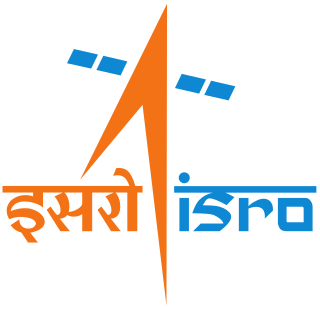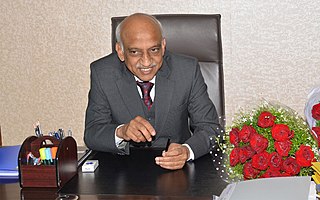
The Indian Space Research Organisation is India's national space agency. It serves as the principal research and development arm of the Department of Space (DoS), overseen by the Prime Minister of India, with the Chairman of ISRO also serving as the chief executive of the DoS. It is primarily responsible for space-based operations, space exploration, international space cooperation and the development of related technologies. The agency maintains a constellation of imaging, communication and remote sensing satellites. It operates the GAGAN and IRNSS satellite navigation systems. It has sent three missions to the Moon and one mission to Mars.

Chandrayaan-1 was the first Indian lunar probe under the Chandrayaan programme. It was launched by the Indian Space Research Organisation (ISRO) in October 2008, and operated until August 2009. The mission consisted of an orbiter and an impactor. India launched the spacecraft using a PSLV-XL rocket on 22 October 2008 at 00:52 UTC from Satish Dhawan Space Centre, at Sriharikota, Andhra Pradesh. The mission was a major boost to India's space program, as India researched and developed its own technology to explore the Moon. The vehicle was inserted into lunar orbit on 8 November 2008.

Satish Dhawan Space Centre – SDSC is the primary spaceport of the Indian Space Research Organisation (ISRO), located in Sriharikota, Tirupati district, Andhra Pradesh.

Mylswamy Annadurai is an Indian scientist working as vice president for Tamil Nadu State Council for Science and Technology, Chairman, Board of Governors, National Design and Research Forum. He is often dubbed as the "Moon Man of India".

The Indian Space Research Organisation (ISRO), over the years, has established a comprehensive global network of ground stations to provide Telemetry, Tracking and Command (TTC) support to satellite and launch vehicle missions. These facilities are grouped under ISRO Telemetry, Tracking and Command Network (ISTRAC) with its headquarters at Bangalore, India.

AstroSat is India's first dedicated multi-wavelength space telescope. It was launched on a PSLV-XL on 28 September 2015. With the success of this satellite, ISRO has proposed launching AstroSat-2 as a successor for AstroSat.

Indian Regional Navigation Satellite System (IRNSS), with an operational name of NavIC, is an autonomous regional satellite navigation system that provides accurate real-time positioning and timing services. It covers India and a region extending 1,500 km (930 mi) around it, with plans for further extension up to 3,000 km (1,900 mi). An extended service area lies between the primary service area and a rectangle area enclosed by the 30th parallel south to the 50th parallel north and the 30th meridian east to the 130th meridian east, 1,500–6,000 km (930–3,730 mi) beyond borders where some of the NavIC satellites are visible but the position is not always computable with assured accuracy. The system currently consists of a constellation of eight satellites, with two additional satellites on ground as stand-by.
Cartosat-2A is an Earth observation satellite in a Sun-synchronous orbit and the third of the Cartosat series of satellites. The satellite is the thirteenth satellite in the Indian Remote Sensing (IRS) satellite series to be built, launched by the Indian Space Research Organisation.

Indian Deep Space Network (IDSN) is a network of large antennas and communication facilities operated by the Indian Space Research Organisation to support the interplanetary spacecraft missions of India. Its hub is located at Byalalu, Ramanagara in the state of Karnataka in India. It was built under the leadership of S K Shivakumar, the then ISTRAC Director and inaugurated on 17 October 2008 by the former ISRO chairman G. Madhavan Nair.

Chandrayaan-2 is the second lunar exploration mission developed by the Indian Space Research Organisation (ISRO) after Chandrayaan-1. It consists of a lunar orbiter, the Vikram lunar lander, and the Pragyan rover, all of which were developed in India. The main scientific objective is to map and study the variations in lunar surface composition, as well as the location and abundance of lunar water.

Dr. S. K. Shivakumar was an Indian Distinguished Scientist from Karnataka state who worked at the Indian Space Research Organisation (ISRO) centres. He was awarded the Padma Shri, the fourth highest civilian award of India, in 2015.

K. Radhakrishnan a.k.a. Koppillil Radhakrishnan is an Indian space scientist who headed the Indian Space Research Organisation (ISRO) as Chairman of Space Commission, Secretary of the Department of Space, Government of India. Under his leadership, India became the first country to reach Mars in its first attempt.
Thekkethil Kochandy Alex is an Indian space scientist. He was the director of the ISRO Satellite Centre (ISAC) of Indian Space Research Organisation (ISRO) (2008–2012) and Member, Space Commission. He specialized in electro-optic systems and satellite technology. Starting with the first Indian satellite Aryabhata, he has been responsible for the sensor systems in all the Indian satellites. Under his leadership the Laboratory for Electro Optics Systems (LEOS) was established in 1993 and from the inception he was its director till 2008. He was conferred "Dr. Vikram Sarabhai Distinguished Professorship" in 2011.

Mars Orbiter Mission (MOM), unofficially known as Mangalyaan, is a space probe orbiting Mars since 24 September 2014. It was launched on 5 November 2013 by the Indian Space Research Organisation (ISRO). It was India's first interplanetary mission and it made ISRO the fourth space agency to achieve Mars orbit, after Soviet space program, NASA, and the European Space Agency. It made India the first Asian nation to reach Martian orbit and the second national space agency in the world to do so on its maiden attempt after the European Space Agency did in 2003.

Subbiah Arunan is an Indian scientist and Padma Shri awardee, known for his role in the Mars Orbiter Mission of Indian Space Research Organisation (ISRO). He finished his schooling in St. Mary's Higher Secondary School, Vikramasingapuram in Tirunelveli Dist. He was born in Kothaiseri, Tirunelveli district, Tamil Nadu and completed his Mechanical engineering from Coimbatore Institute of Technology.
Delta-Differential One-Way Ranging is an interplanetary radio-tracking and navigation technique.

Aluru Seelin Kiran Kumar is an Indian space scientist and former chairman of the Indian Space Research Organisation, having assumed office on 14 January 2015. He is credited with the development of key scientific instruments aboard the Chandrayaan-1 and Mangalyaan space crafts. In 2014, he was awarded the Padma Shri, India's fourth highest civilian award, for his contributions to the fields of science and technology. Kiran Kumar previously served as Director of Ahmedabad Space Applications Centre.
Mars Lander Mission (MLM) or Mangalyaan-2, is a proposed second mission to Mars by the Indian Space Research Organisation (ISRO).
ISRO Satellite Integration and Testing Establishment (ISITE) is an integrated satellite testing facility established under the aegis of ISRO Satellite Center by Indian Space Research Organisation in 2006. Started with an area of 1000 sq ft. at the time when the Aryabhatta satellite was launched, the testing facility is spread over 100-acre and can integrate and test six satellites of the INSAT class at different stages simultaneously: 2 communications, 2 remote sensing and 2 foreign satellites. The investment on the facility is so far about Rs 220 crore and ISRO plans to make a further investment of Rs 100 crore. The facility has also carried out vibration and acoustic tests of Mars Orbiter Mission (MOM) spacecraft.

Ritu Karidhal Srivastava is an Indian scientist and aerospace engineer working in the Indian Space Research Organisation (ISRO). She was a Deputy Operations Director to India's Mars orbital mission, Mangalyaan. She has been referred to as one of the many "Rocket Women" of India. Giving tribute to her excellence in Mangalayaan mission, a Bollywood film Mission Mangal was created where Indian actress Vidya Balan did her role.















